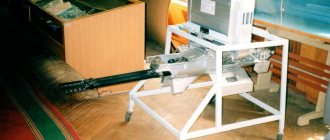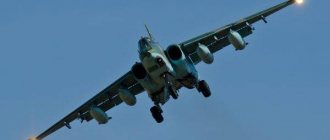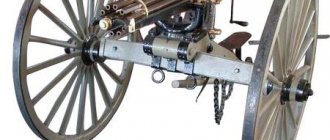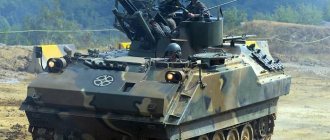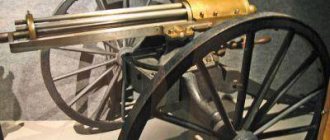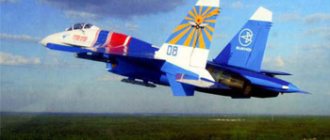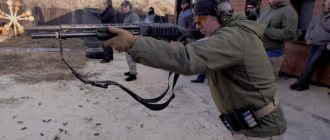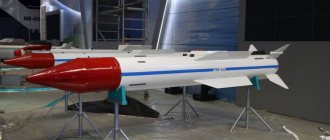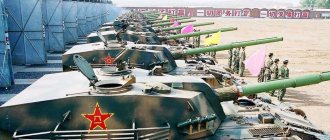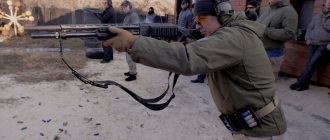This term has other meanings, see Vulcan (meanings).
| Avro Vulcan | |
| Avro "Vulcan" with open bomb bay | |
| Type | strategic bomber |
| Developer | Avro Aircraft |
| Manufacturer | Avro |
| Chief designer | Roy Chadwick[d] and Stuart Davis[d] |
| First flight | August 30, 1952 |
| Start of operation | 1956 |
| End of operation | March 1984 |
| Operators | Royal Air Force |
| Years of production | 1956—1965 |
| Units produced | 136 (including prototypes) |
| Media files on Wikimedia Commons | |
Avro "Vulcan"
(eng. Avro Vulcan) is a British strategic bomber, the second of the V-series bombers. Made its first flight on August 31, 1952. A total of 136 aircraft were produced, including prototypes.
The Vulcan was in service with the Royal Air Force from 1956 to 1984, thus becoming the last British strategic bomber. Aircraft of this type made several combat missions during the Falklands War. One Vulcan (serial number XH558) was returned to airworthy condition[1], in 2012 the aircraft made a demonstration flight at the Farnborough Air Show[2] and repeatedly participated in various air shows. However, after 2015, flights are unlikely, since the engines have exhausted their service life, and its extension is impossible due to the lack of spare parts[3].
History[ | ]
Development[ | ]
The history of all strategic bombers begins with the creation of nuclear weapons, which required delivery vehicles. In 1947, in Great Britain, a decision was made to create a bomber capable of carrying one bomb weighing 4.5 tons over a distance of up to 3,000 km at a speed of at least 900 km/h and a service ceiling of up to 15,000 m[4].
In the winter of 1947, under the leadership of chief designer R. Chadwick, work began on creating a new long-range bomber for the British Air Force. The specific requirements of the British Air Force were that the high-speed bomber being created had to operate from small British airfields. The Royal Air Force simply could not afford to build an extensive network of air bases[4].
After the war, she received a large amount of captured materials on high-speed aerodynamics and technologies developed by German specialists. These materials were actively used in the creation of a new aircraft. For the new aircraft, a tailless design with a delta wing of a thick profile and a relatively small aspect ratio of a large area was chosen. The armament and engines were recessed into the hull[4].
In May 1947, the project for a new aircraft was presented to the British Ministry of Supply, which was responsible for the creation of aircraft. In November 1947, after lengthy debates, the proposals received final approval, which made it possible to begin full-scale work on the creation of the aircraft. The aircraft received the designation “type 689”[4].
In 1948, a new bomber model was produced, in which the airframe configuration was revised: the vertical fins became all-moving, the air intakes changed from round to oval, and the wing angle was changed. During 1948, a large amount of testing was carried out in wind tunnels. Based on the test results, a new wing was developed, which had a larger internal volume and a simpler design [4].
In the fall of 1949, the technical design of the 698 aircraft was completed. Compared to the original project, the appearance of the aircraft has changed significantly. Instead of two rotating fins, one classic-looking fin was installed, the air intakes were recessed into the leading edge of the wing, and the weight of the airframe increased. Construction of the first aircraft began in April 1950. The first flight took place on August 30, 1952 at an airfield near Woodfort. The Royal Air Force gave it the name "Vulcan"[4].
Operation[ | ]
The first Avro Vulcan aircraft entered service with the Royal Air Force in September 1956.[5]
Vulcan aircraft took part in the bombing of Port Stanley during the Falklands War in 1982 (Operation Black Buck). As a result of the raid, the runway on the islands captured by the Argentines was damaged and a radar installation was destroyed. This operation was the first and last combat use of Vulcans.
The final flight of the last Avro Vulcan bomber took place in October 2015 as part of the marketing campaign for the Aston Martin Vulcan sports car.[6][7]
Notes
By purpose Bombers: 730 • Aldershot • Antelope • Buffalo • Lancaster • Lincoln • Manchester •
Vulcan
Transport:Andover • Lancastrian • York
Marine patrols:
Anson • Bison • Shackleton
Passenger:
748 • Ashton • Commodore • Eighteen • Five • • Six • Ten • Tudor
Educational and training:
504 • Athena • Cadet • Prefect • Tutor
Fighters:
Avenger • Avocet • Spider
Sports:
Avian • Baby
Experimental:
707 • Ashton • Burga • Duigan
Early:
Roe I Biplane • Roe I Triplane • Roe II Triplane • Roe III Triplane • Roe IV Triplane
Construction[ | ]
The Avro "Vulcan" is built according to a tailless design with a fuselage integrated into the wing, in the thick root bulges of which the engines are located (2 on each side). The layout turns out to be very close to a flying wing, differing from it in a dedicated fuselage with a large area fin. With an aircraft length of 30.45 m, the chord at the root of the wing is about 18 m (60% of the total length). The main structure of the airframe is made of sheet light alloys.
Fuselage
The fuselage has a circular cross-section with a constant cross-section of about 3 m. In the forward part of the fuselage, in front of the cockpit, there is a radar compartment (radar). An access hatch and a bomber optical sight blister are installed at the bottom of the bow. In the middle part of the fuselage there is a bomb bay 8.5 m long. In the rear part there is a radar compartment for protecting the rear part of the fuselage, the antenna of which is covered by a radio-transparent radome. At the bottom of the tail section, under the rudder, there is a brake parachute container[4].
The crew cabin is sealed. The aircraft's crew consists of five people - two pilots, a navigator-bombardier, a navigator and a radio-electronic countermeasures (RES) officer. Airplane pilots sit on ejection seats. Before ejection, the cockpit canopy is shot off. The remaining crew members, in the event of an emergency, leave the aircraft through the entrance hatch[4].
Wing
The wing is two-spar triangular in plan. The aircraft wing has an increased span and sweep along the trailing edge. In places of sagging, the nose of the wing has a sharp leading edge and is deflected downward. There are removable panels at the bottom of the wing for access to the engines. The spars are installed parallel to the leading edge of the wing root. The hinge axes of the control surfaces are located on the rear side member. The ribs are perpendicular to the rear spar[4].
Air brakes - eight rectangular panels, installed in pairs in the upper and lower parts of the wing on two retractable brackets. The height position of the panels and the angle of their installation can vary. The maximum deflection angle of the air brakes is 90 degrees. The effectiveness of air brakes is quite high: when the brakes are fully released, the aircraft drag increases by 2.5 times[4].
Ailerons are installed at the ends of the wing. The elevators are located between the ailerons and the center section. The ailerons and elevators consist of two sections with separate control of each section. The area of the elevators is 20 m², the area of the ailerons is 10 m². 36 flow turbulators are installed on the upper surface of the wing in front of the line of possible boundary layer separation [4].
Chassis
The chassis is tricycle. The main landing gear is liquid-damped and equipped with eight-wheel bogies. All 16 wheels are equipped with automatic braking. The front landing gear has a two-wheel steerable bogie.
Vertical tail
The keel is swept, in plan it has a trapezoidal shape[4].
Power point
Four turbojet engines (turbojet engines) Bristol "Olympus" 102 (4x5450 kgf) or "Olympus" 104 (4x5900 kgf). Each of the two engines had a common air intake, which was separated by a partition at some distance from the leading edge. Between the air intake and the fuselage there is a boundary layer removal system. Fuel tanks are located in the wing and fuselage[4].
Armament
Bomb load weighing up to 9500 kg (normal 4500 kg), including up to 21 free-fall bombs of 450 kg caliber. One Blue Steel guided missile, semi-recessed under the fuselage[4].
General aircraft systems[ | ]
The control system is booster. A damper is installed in the yaw channel—rudder control.
Anti-icing system - thermal.[8]
Target equipment[ | ]
- panoramic bomber radar station
- optical sight
- on-board computer
- doppler navigation radar
- radio identification unit "friend or foe"
- instrument landing equipment
- VHF radio station
- HF radio station
- radar reconnaissance station
- enemy radar irradiation warning station
- active jamming interceptors
- passive jamming device[8]
Excerpt describing Avro Vulcan
“Well, in exactly the same way she shuddered, in the same way she came up and smiled timidly then, when it was already happening,” Natasha thought, “and in the same way... I thought that something was missing in her.” - No, this is the choir from the Water-bearer, do you hear! – And Natasha finished singing the choir’s tune to make it clear to Sonya. -Where did you go? – Natasha asked. - Change the water in the glass. I'll finish the pattern now. “You’re always busy, but I can’t do it,” said Natasha. -Where is Nikolai? - He seems to be sleeping. “Sonya, go wake him up,” said Natasha. - Tell him that I call him to sing. “She sat and thought about what it meant, that it all happened, and, without resolving this question and not at all regretting it, again in her imagination she was transported to the time when she was with him, and he looked with loving eyes looked at her. “Oh, I wish he would come soon. I'm so afraid that this won't happen! And most importantly: I'm getting old, that's what! What is now in me will no longer exist. Or maybe he’ll come today, he’ll come now. Maybe he came and is sitting there in the living room. Maybe he arrived yesterday and I forgot.” She stood up, put down the guitar and went into the living room. All the household, teachers, governesses and guests were already sitting at the tea table. People stood around the table, but Prince Andrei was not there, and life was still the same. “Oh, here she is,” said Ilya Andreich, seeing Natasha enter. - Well, sit down with me. “But Natasha stopped next to her mother, looking around, as if she was looking for something. - Mother! - she said. “Give it to me, give it, mom, quickly, quickly,” and again she could hardly hold back her sobs. She sat down at the table and listened to the conversations of the elders and Nikolai, who also came to the table. “My God, my God, the same faces, the same conversations, dad holding the cup in the same way and blowing in the same way!” thought Natasha, feeling with horror the disgust rising in her against everyone at home because they were still the same. After tea, Nikolai, Sonya and Natasha went to the sofa, to their favorite corner, where their most intimate conversations always began. “It happens to you,” Natasha said to her brother when they sat down in the sofa, “it happens to you that it seems to you that nothing will happen - nothing; what was all that was good? And not just boring, but sad? - And how! - he said. “It happened to me that everything was fine, everyone was cheerful, but it would come to my mind that I was already tired of all this and that everyone needed to die.” Once I didn’t go to the regiment for a walk, and there was music playing... and so I suddenly became bored... - Oh, I know that. I know, I know,” Natasha picked up. – I was still little, this happened to me. Do you remember, once I was punished for plums and you all danced, and I sat in the classroom and sobbed, I will never forget: I was sad and I felt sorry for everyone, and myself, and I felt sorry for everyone. And, most importantly, it wasn’t my fault,” Natasha said, “do you remember? “I remember,” said Nikolai. “I remember that I came to you later and I wanted to console you and, you know, I was ashamed. We were terribly funny. I had a bobblehead toy then and I wanted to give it to you. Do you remember? “Do you remember,” Natasha said with a thoughtful smile, how long ago, long ago, we were still very little, an uncle called us into the office, back in the old house, and it was dark - we came and suddenly there was standing there... - Arab, - Nikolai finished with a joyful smile, “how can you not remember?” Even now I don’t know that it was a blackamoor, or we saw it in a dream, or we were told. - He was gray, remember, and had white teeth - he stood and looked at us... - Do you remember, Sonya? - Nikolai asked... - Yes, yes, I also remember something, - Sonya answered timidly... - I asked my dad and mom about this blackamoor, - said Natasha. - They say that there was no blackamoor. But you remember! - Oh, how I remember his teeth now. - How strange it is, it was like a dream. I like it. - Do you remember how we were rolling eggs in the hall and suddenly two old women began to spin around on the carpet? Was it or not? Do you remember how good it was? - Yes. Do you remember how dad in a blue fur coat fired a gun on the porch? “They turned over, smiling with pleasure, memories, not sad old ones, but poetic youthful memories, those impressions from the most distant past, where dreams merge with reality, and laughed quietly, rejoicing at something. Sonya, as always, lagged behind them, although their memories were common. Sonya did not remember much of what they remembered, and what she did remember did not arouse in her the poetic feeling that they experienced. She only enjoyed their joy, trying to imitate it. She took part only when they remembered Sonya's first visit. Sonya told how she was afraid of Nikolai, because he had strings on his jacket, and the nanny told her that they would sew her into strings too. “And I remember: they told me that you were born under cabbage,” said Natasha, “and I remember that I didn’t dare not believe it then, but I knew that it wasn’t true, and I was so embarrassed.” During this conversation, the maid's head poked out of the back door of the sofa room. “Miss, they brought the rooster,” the girl said in a whisper. “No need, Polya, tell me to carry it,” said Natasha. In the middle of the conversations going on in the sofa, Dimmler entered the room and approached the harp that stood in the corner. He took off the cloth and the harp made a false sound. “Eduard Karlych, please play my beloved Nocturiene by Monsieur Field,” said the voice of the old countess from the living room. Dimmler struck a chord and, turning to Natasha, Nikolai and Sonya, said: “Young people, how quietly they sit!” “Yes, we are philosophizing,” Natasha said, looking around for a minute and continuing the conversation. The conversation was now about dreams. Dimmer started to play. Natasha silently, on tiptoe, walked up to the table, took the candle, took it out and, returning, quietly sat down in her place. It was dark in the room, especially on the sofa on which they were sitting, but through the large windows the silver light of the full moon fell onto the floor.
Performance characteristics[ | ]
The characteristics of the B.Mk.1 variant[8] are given.
Specifications[ | ]
- Crew: 5 people
- Length: 29.61 m
- Wingspan: 30.18 m
- Height: 7.93 m
- Wing area: 340.0 m²
- Normal take-off weight: 86,000 kg
- Maximum take-off weight: 91,000 kg
- Engines: 4× turbojet Bristol “Olympus” 102 (4×5450 kgf) or “Olympus” 104 (4×5900 kgf)
Projections of the Vulcan B.2 bomber
Flight characteristics[ | ]
- Maximum speed: 1039 km km/h (=0.96)
- Cruise speed: 913 km/h / M=0.86 at 45,000 ft (14,000 m)
- Combat radius: 4200 km
- Maximum range: 9000 km
- Service ceiling: 17000 m
Armament[ | ]
- 1 × "Blue Danube" - atomic bomb
- 1 × Violet Club - atomic bomb (400 kT)
- 1 × Mark 5 - US made atomic bomb
- 1 × Yellow Sun Mk.1 atomic bomb (400 kT)
- 1 × Yellow Sun Mk 2 thermonuclear bomb (1.1 MT)
- 1 × Red Beard - atomic bomb
- 1 × cruise missile with nuclear warhead "Blue Steel"
- Conventional free-fall bombs: up to 21 1,000 lb (454 kg) bombs
Comparative characteristics of various modifications[ | ]
| B.1 | B.1A | B.2 | B.2A (B.2BS) | B.2 (MRR) or (K) | |
| Wingspan | 30.2 m | 33.8 m | |||
| Length | 28.4 m | 30.5 m[9] | 32.2 m | 30.5 m | 30.5 m |
| Height | 8.1 m | 8.3 m | |||
| Wing area | 330.2 m² | 368.3 m² | |||
| Maximum take-off weight | 86,000 kg | 93,000 kg | |||
| Cruising speed | = 0,86 | ||||
| Maximum speed | M = 0.93 | M = 0.92 | |||
| Practical range | 6293 km | 7402 km | |||
| Service ceiling | 17,000 m | 18,000 m | |||
| Engines | 4x Bristol Siddeley Olympus 101, 102 or 104 | 4× Bristol Siddeley Olympus 201, 202, 203 or 301 | 4× Bristol Siddeley Olympus 201, 202, 203 | 4× Bristol Siddeley Olympus 201, 202, 203 | |
| Fuel reserve (Avtur/Mains only) | 42051 l | 42097 l | |||
| Armament | thermonuclear bomb or 21×453.6 kg bombs | 1 Blue Steel missile with nuclear warhead or 21×453.6 kg bombs | No | ||
- Media files on Wikimedia Commons
Design and modifications
M61 is a multi-barrel gun with a rotating barrel block. The design of the gun, despite the number of barrels, is quite simple. Each of the Vulcan's six barrels has its own bolt and chamber.
During a full revolution of the block, the barrel manages to go through a cycle that includes firing, ejecting the spent cartridge case and chambering a new projectile.
The bolts are moved using rollers attached to them, which move along a special groove in the receiver.
Locking the barrels is done by turning the bolt cylinder. The ignition of the cartridge case is electrical. The automation of the basic modification of the Vulcan operates due to an external drive from the hydraulic system of the carrier aircraft. On other versions, the barrel block could be spun by an electric motor from the on-board network.
Modifications
The barrel drive system may vary depending on the modification, but in most cases it is external, hydraulic.
M61A2 is a lightweight version installed on F-22 and later F/A-18 fighters. Due to thinner barrels and replacement of metal parts, the weight of the gun was reduced to 92 kg.
M130 (GAU-4) - “Vulcan”, which does not require external power. The block of barrels is rotated by the exhausted powder gases. This modification was used for installation in suspended cannon nacelles.
M197 is a three-barreled Vulcan with a rate of fire reduced to 1500 rounds per minute. Intended to arm AH-1 Cobra attack helicopters.
M195 is a version designed for installation on helicopters with six shortened barrels. As a result, it was not accepted into service.
XM301 is the most lightweight Vulcan with two barrels, which was supposed to equip RAH-66 Comanche helicopters.
M168 – cannon for anti-aircraft artillery installations.
Even more famous than the above-mentioned Vulcan variants is the six-barreled M134 Minigun machine gun of 7.62mm caliber, designed for arming helicopters. This is, in fact, a smaller version of the M61 cannon.
Notes[ | ]
- The British are looking for funds to save the last Vulcan bomber, lenta.ru 03/01/2009
- Landing the XH558 and running on two wheels
- Vulcan to fly over Goodwood – and on to 2015 – Telegraph
- ↑ 1234567891011121314
Ilyin, 1994. - C. M. Lambert.
Bomex By Vulcan (English) // Flight International: magazine. - 1958. - January. — P. 66. Archived November 2, 2012. - Darren Moss.
Aston Martin Vulcan meets its namesake: Vulcan bomber XH558
(unspecified)
.
Autocar
. Haymarket Automotive (2 October 2015). Date accessed: July 27, 2021. - Leonid Popov.
The Aston Martin Vulcan coupe has arrived to its first customers
(unspecified)
.
Drive
(November 27, 2015). Access date: November 27, 2015. - ↑ 123
Ilyin V. E., Levin M. A. Bombers. T.2. - M.: Victoria, AST, 1997. - P. 164. - 32.2 m with filling probe
Literature
- Ilyin V.
“Swan song” of the English aircraft industry. Avro “Volcano” (Russian) // Wings of the Motherland. - M., 1994. - No. 5. - P. 21-25. — ISSN [www.sigla.ru/table.jsp?f=8&t=3&v0=0130-2701&f=1003&t=1&v1=&f=4&t=2&v2=&f=21&t=3&v3=&f=1016&t=3&v4=&f=1016&t=3&v5 =&bf=4&b=&d=0&ys=&ye=&lng=&ft=&mt=&dt=&vol=&pt=&iss=&ps=&pe=&tr=&tro=&cc=UNION&i=1&v=tagged&s=0&ss=0&st=0&i18n=ru&rlf=&psz =20&bs=20&ce=hJfuypee8JzzufeGmImYYIpZKRJeeOeeWGJIZRrRRrdmtdeee88NJJJJpeeefTJ3peKJJ3UWWPtzzzzzzzzzzzzzzzzbzzvzzpy5zzjzzzzzzzzzzzzzzzzzzzzzzzzz zzzzztzzzzzzzbzzzzzzzzzzzzzzzzzzzzzzzzzzzzzzzzzyeyTjkDnyHzTuueKZePz9decyzzLzzzL*.c8.NzrGJJvufeeeeeJheeyzjeeeeJh*peeeeKJJJJJJJJJmjHvOJJJJJJJJfe eeieeeeSJJJJSJJJ3TeIJJJJ3..E.UEAcyhxD.eeeeeeuzzzLJJJJ5.e8JJJheeeeeeeeeeeeyeyeK3JJJJJJJJ*s7defeeeeeeeeeeeeeeeeeeeeeeeeSJJJJJJJZIJJzzz1..6LJJJJJJtJJZ4….EK*&deb ug=false 0130-2701].
Ammunition
Initially, two types of projectiles were developed for the Vulcan cannon: the armor-piercing incendiary M53 and the high-explosive fragmentation M56. The first is a simple steel blank with an aluminum ballistic tip, weighing 100 grams. The incendiary composition is located between the steel body and the aluminum tip. Initial speed – 1030 m/s. The high-explosive fragmentation projectile is loaded with 10 grams of explosive (“composition B”), the damage radius is estimated at 2 meters.
The M246 projectile was developed for anti-aircraft guns. It is distinguished by the presence of a self-liquidator. Since the end of 1980, “semi-armor-piercing” shells such as PGU-28 or M940 began to spread. Their difference is a body made of heat-strengthened steel and the absence of a fuse as such.
When a cannon shell hits a target, the incendiary composition ignites, and its flash detonates the explosive charge. Due to the slow action of this process and the durable casing, the projectile explodes inside the target. Armor penetration - about 12 mm at a distance of 500 meters.
Specialized projectiles with high armor penetration were developed for naval anti-aircraft Vulcans.
The Mk.149 projectile is a sub-caliber projectile, with a detachable tray. The core was originally made from depleted uranium. Later, tungsten carbide was used for this purpose. The Mk.244 projectile has an increased core mass.
